Page 333 of 387

Themileageyoucanexpectfrom
yourvehicletiresisthesameas
comparable mid-and rear-engine
sports cars, and it will vary greatly
with your driving habits.
If you drive moderately, the f ront
tires could last more than 10,000
miles (16,000 km). However, the
mileage will be substantially less if
you tend to drive your vehicle at the
upper limits of its capabilities.
You should caref ully inspect your
vehicle’s tires f or wear, damage, and
proper inf lation every 7,500 miles
(12,000 km).Replace your tires with radial tires of
the same size, load range, speed
rating, and maximum cold tire
pressure rating (as shown on the
tire’s sidewall).
Mixing radial and bias-ply tires on
your vehicle can reduce braking
ability, traction, and steering
accuracy. Using tires of a dif f erent
size or construction can cause the
ABS and vehicle stability assist
system (VSA) to work inconsistently.
It is best to replace all f our tires at
thesametime.If thatisnotpossible
or necessary, replace the two f ront
tires or two rear tires as a pair.
Replacing just one tire can seriously
af f ect your vehicle’s handling.The ABS and VSA system work by
comparing the speed of the wheels.
When replacing tires, use the same
size originally supplied with the
vehicle. Tire size and construction
can af f ect wheel speed and may
cause the ABS or VSA system to
activate.
Replacement wheels are available at
your dealer.
If you ever replace a wheel, make
sure that the wheel’s specif ications
match those of the original wheels.
Also be sure you use only TPMS
specif ic wheels (if equipped). If you
do not, the tire pressure monitoring
system will not work.
CONT INUED
Tires
Replacing T ires and Wheels
Maint enance
319
Table of Contents
Page 339 of 387
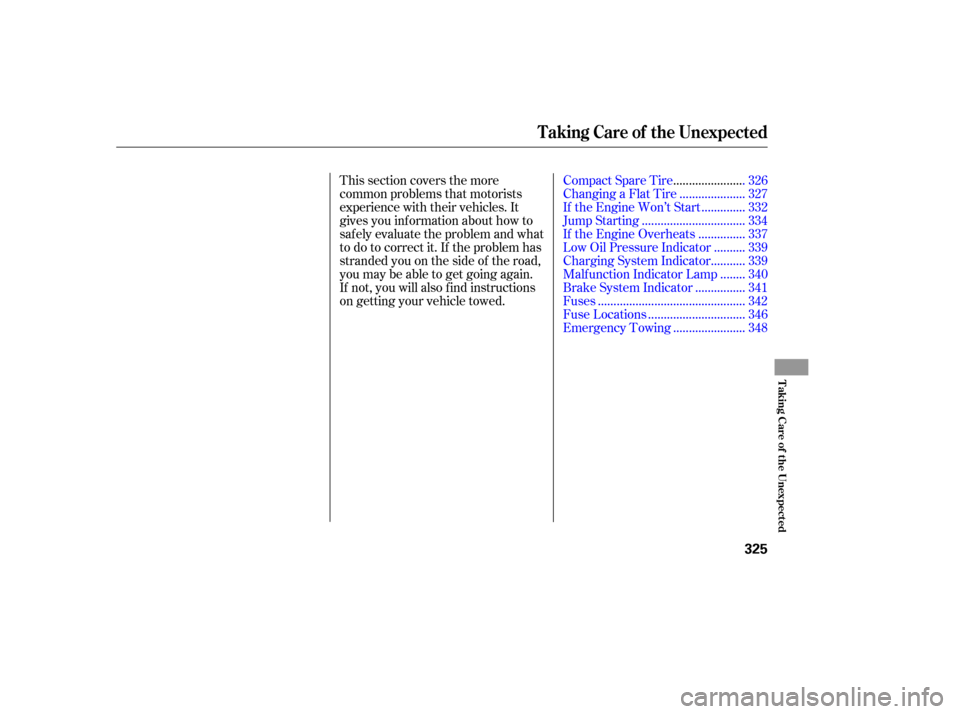
This section covers the more
common problems that motorists
experience with their vehicles. It
gives you inf ormation about how to
safely evaluate the problem and what
to do to correct it. If the problem has
stranded you on the side of the road,
you may be able to get going again.
If not, you will also f ind instructions
on getting your vehicle towed.......................Compact Spare Tire . 326
....................
Changing a Flat Tire . 327
.............
If the Engine Won’t Start . 332
................................
Jump Starting . 334
..............
If the Engine Overheats . 337
.........
Low Oil Pressure Indicator . 339
..........
Charging System Indicator . 339
.......
Malf unction Indicator Lamp . 340
...............
Brake System Indicator . 341
..............................................
Fuses . 342
..............................
Fuse Locations . 346
......................
Emergency Towing . 348
Taking Care of the Unexpected
T aking Care of t he Unexpect ed
325
Page 340 of 387
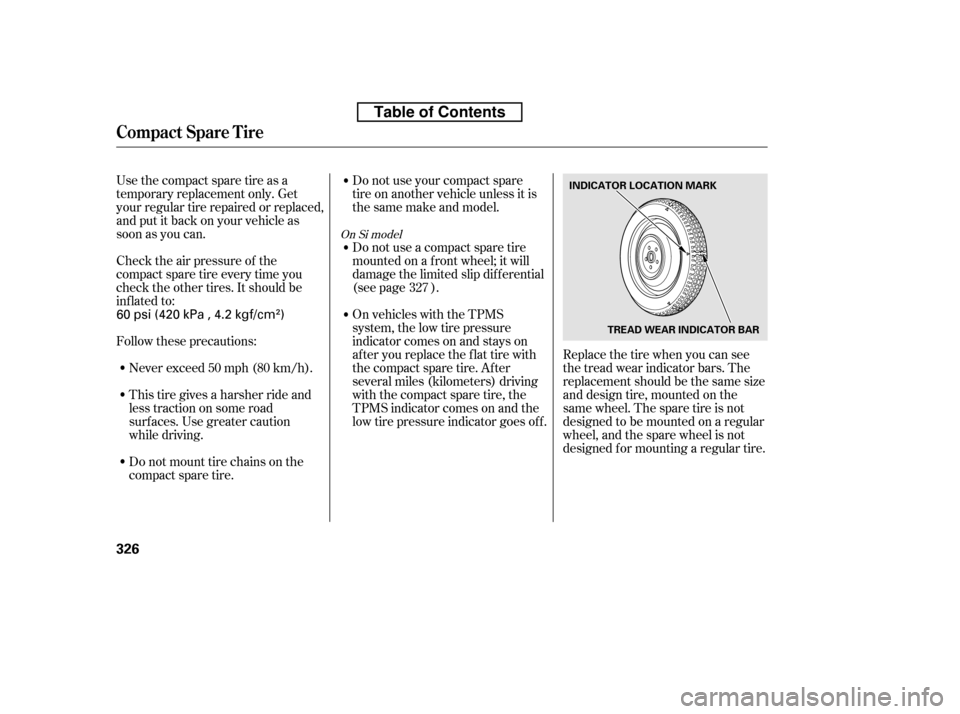
Check the air pressure of the
compact spare tire every time you
check the other tires. It should be
inf lated to:
Use the compact spare tire as a
temporary replacement only. Get
your regular tire repaired or replaced,
and put it back on your vehicle as
soon as you can.
Replace the tire when you can see
the tread wear indicator bars. The
replacement should be the same size
and design tire, mounted on the
same wheel. The spare tire is not
designed to be mounted on a regular
wheel, and the spare wheel is not
designed f or mounting a regular tire.
Follow these precautions:
This tire gives a harsher ride and
less traction on some road
surf aces. Use greater caution
while driving.
Never exceed 50 mph (80 km/h).
Do not mount tire chains on the
compact spare tire. Do not use your compact spare
tire on another vehicle unless it is
thesamemakeandmodel.
Do not use a compact spare tire
mounted on a f ront wheel; it will
damage the limited slip dif f erential
(see page ).
On vehicles with the TPMS
system, the low tire pressure
indicator comes on and stays on
after you replace the flat tire with
the compact spare tire. Af ter
several miles (kilometers) driving
with the compact spare tire, the
TPMS indicator comes on and the
low tire pressure indicator goes of f .
327
On Si model
Compact Spare Tire
326
INDICATOR LOCATION MARK
TREAD WEAR INDICATOR BAR
60 psi (420 kPa , 4.2 kgf/cm)
Table of Contents
Page 345 of 387
Place the flat tire face down in the
spare tire well.
Remove the spacer cone f rom the
wing bolt, turn it over, and put it
back on the bolt.
Securetheflattirebyscrewing
the wing bolt back into its hole.Lower the trunk f loor, and close
the trunk lid.
Store the jack and tools in the tool
case. Place the tool case in the
center of the f lat tire.
Store the wheel cover or center
cap in the trunk. Make sure it does
not get scratched or damaged.
Your vehicle’s original tire has a
tire pressure monitoring system
sensor. To replace a tire, ref er to
(see
page ).
15. 16. 17. 18. 19.
20. 21.
272
CONT INUED
On U.S. models
Changing a Flat T ire
Changing a T ire with T PMS
T aking Care of t he Unexpect ed
331
WING BOLT SPACER CONE
For normaltire For sparetire
Loose items can fly around the
interiorinacrashandcould
seriously injure the occupants.
Store the wheel, jack, and tools
securely before driving.
Table of Contents
Page 364 of 387
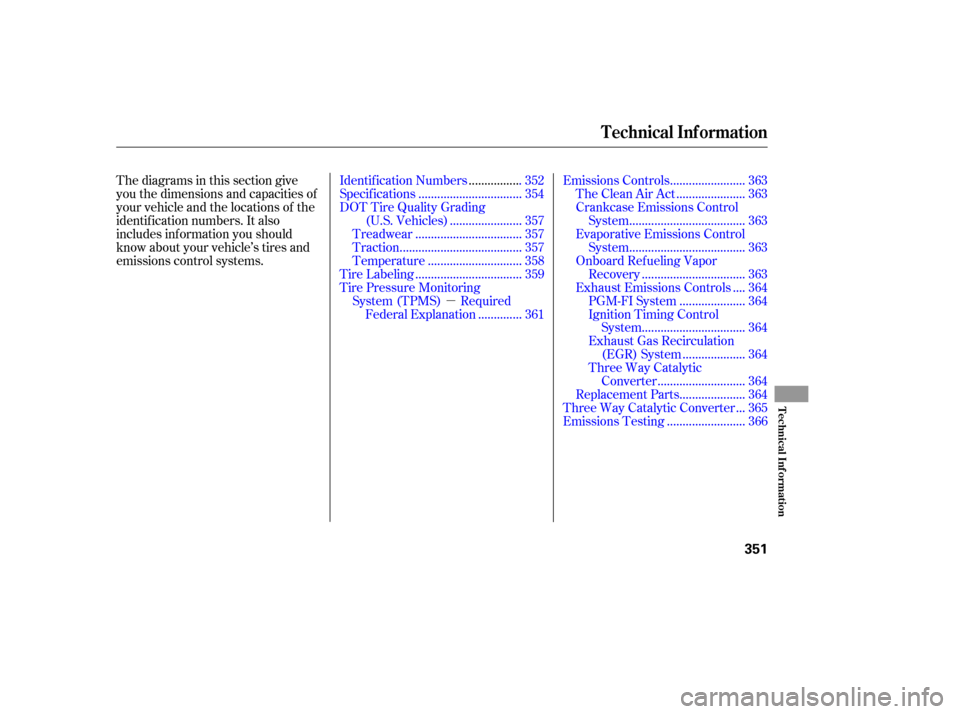
�µ
Thediagramsinthissectiongive
you the dimensions and capacities of
your vehicle and the locations of the
identif ication numbers. It also
includes inf ormation you should
know about your vehicle’s tires and
emissions control systems.
................
Identif ication Numbers . 352
................................
Specif ications . 354
DOT Tire Quality Grading
......................
(U.S. Vehicles) . 357
.................................
Treadwear . 357
......................................
Traction . 357
.............................
Temperature . 358
.................................
Tire Labeling . 359
Tire Pressure Monitoring
System (TPMS) Required .............
Federal Explanation . 361 .......................
Emissions Controls . 363
.....................
The Clean Air Act . 363
Crankcase Emissions Control
....................................
System . 363
Evaporative Emissions Control ....................................
System . 363
Onboard Ref ueling Vapor ................................
Recovery . 363
...
Exhaust Emissions Controls . 364
....................
PGM-FI System . 364
Ignition Timing Control
................................
System . 364
Exhaust Gas Recirculation ...................
(EGR) System . 364
Three Way Catalytic ...........................
Converter . 364
....................
Replacement Parts . 364
..
Three Way Catalytic Converter . 365
........................
Emissions Testing . 366
T echnical Inf ormation
T echnical Inf ormation
351
Page 369 of 387
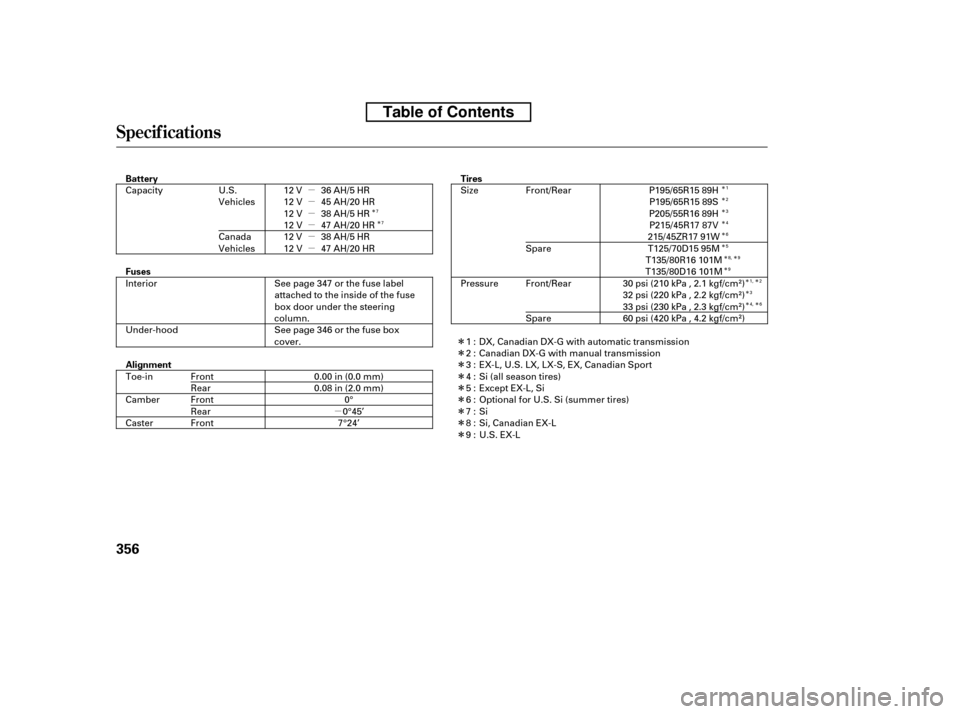
�µ
�µ �µ�µ�µ�µ�µ
�Î�Î�Î�Î�Î�Î�Î�Î�Î
�Î
�Î�Î �Î�Î
�Î
�Î �Î
�Î �Î�Î
�Î
�Î�Î
�Î�Î
Specif ications
356
Fuses
Alignment
Battery
Tires
P195/65R15 89H
Interior
Under-hood
Toe-in
Camber
Caster 7°24’0°45’
0°
0.08 in (2.0 mm)
0.00 in (0.0 mm)
Capacity 12 V
12 V
12 V36 AH/5 HR
38 AH/5 HR
45 AH/20 HR
47 AH/20 HR
12 V
12 V 38 AH/5 HR
47 AH/20 HR
12 V T135/80R16 101MT125/70D15 95M
215/45ZR17 91W P215/45R17 87V
P205/55R16 89H P195/65R15 89S
Size
Pressure
See page 347 or the fuse label
attached to the inside of the fuse
box door under the steering
column.
See page 346 or the fuse box
cover. 60 psi (420 kPa , 4.2 kgf/cm
)
33 psi (230 kPa , 2.3 kgf/cm)
32 psi (220 kPa , 2.2 kgf/cm)
30 psi (210 kPa , 2.1 kgf/cm)
T135/80D16 101M
Front Rear
FrontRear
Front Front/Rear
Spare
U.S.
Vehicles
Canada
Vehicles
Front/Rear
Spare
Si (all season tires)
Canadian DX-G with manual transmission
DX, Canadian DX-G with automatic transmission
Except EX-L, Si
EX-L, U.S. LX, LX-S, EX, Canadian Sport
1: 2:3:4:5:6:7:8:9: Optional for U.S. Si (summer tires)Si
U.S. EX-L
Si, Canadian EX-L
3
1 2 45
7
7 6
9 4, 6
3
1, 2
8, 9
Table of Contents
Page 372 of 387
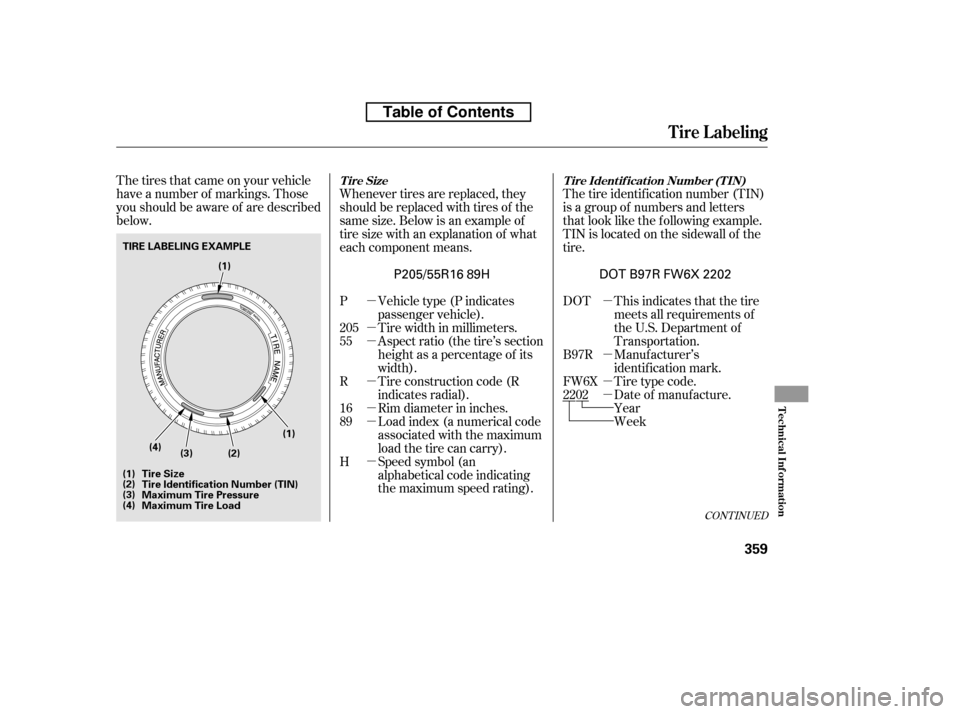
�µ �µ �µ �µ
�µ �µ �µ �µ �µ �µ �µ
The tires that came on your vehicle
have a number of markings. Those
you should be aware of are described
below.
The tire identif ication number (TIN)
is a group of numbers and letters
that look like the f ollowing example.
TIN is located on the sidewall of the
tire.
This indicates that the tire
meets all requirements of
the U.S. Department of
Transportation.
Manuf acturer’s
identification mark.
Tire type code.
Date of manuf acture.
Whenever tires are replaced, they
should be replaced with tires of the
same size. Below is an example of
tire size with an explanation of what
each component means.
Vehicletype(Pindicates
passenger vehicle).
Tire width in millimeters.
Aspect ratio (the tire’s section
height as a percentage of its
width).
Tire construction code (R
indicates radial).
Rim diameter in inches.
Load index (a numerical code
associated with the maximum
load the tire can carry).
Speed symbol (an
alphabetical code indicating
the maximum speed rating). Year
Week
P 55R 16
DOT B97R
FW6X 2202
205 89 H
CONT INUED
T ire Ident if icat ion Number (T IN)
Tire Size
Tire Labeling
T echnical Inf ormation
359
TIRE LABELING EXAMPLE
(1)
(2)
(3)
(4) Tire Size
Maximum Tire Load
Tire Identification Number (TIN)
Maximum Tire Pressure (3)
(1)
(1)
(2)
(4)
DOT B97R FW6X 2202
P205/55R16 89H
Table of Contents
Page 373 of 387
�µ�µ
�µ
�µ
�µ
�µ
Cold Tire Pressure The tire air
pressure when the vehicle has been
parked f or at least three hours or
driven less than 1 mile (1.6 km). Maximum Load Rating Means the
load rating for a tire at the maximum
permissible inf lation pressure f or
that tire.
Recommended Inf lation Pressure
The cold tire inf lation pressure
recommended by the manuf acturer.
Treadwear Indicators (TWI)
Means the projections within the
principal grooves designed to give a
visual indication of the degrees of
wear of the tread.
Maximum Inf lation Pressure The
maximum tire air pressure that the
tire can hold.
Load Rating Means the maximum
load that a tire is rated to carry for a
given inf lation pressure.
Tire Labeling
Glossary of T ire T erminology
360
Table of Contents